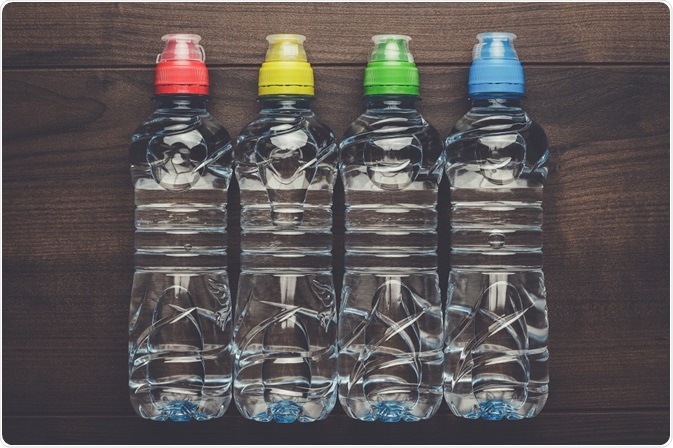By Jeyashree Sundaram, MBA
Bisphenol A (BPA) is an inorganic compound used in the production of polycarbonate (PC) plastics and epoxy resins. PC plastics are hard and are used in manufacturing baby bottles, reusable water bottles, food containers, tableware, and other storage containers. Epoxy resins are coated on the inner linings of metal containers such as food cans, bottle tops, and water supply tubing, in order to prevent corrosion of the metal leading to contamination of the stored food products.

Credit: Ruslan Grumble/ Shutterstock.com
The release of BPA from stored containers (PC containers and epoxy-varnished metallic containers) into foods and liquids during heating promotes the transfer of BPA contents leading to the consumption of food or liquids containing BPA. BPA is also transferred from mother to infant during breastfeeding. These are some of the possible ways in which people are exposed to BPA. Exposure to BPA causes several effects on human health such as obesity, premature puberty, repeated miscarriages, and diabetes.
Methods for reducing BPA exposure
1. In bottle-fed infants
Breast-feeding infants have a negligible risk of BPA exposure. However, the risk becomes higher when mothers switch over to bottle feeding. Some measures to reduce the risk of BPA exposure in infants and babies are as follows:
- Avoid the use of plastic bottles
- The use of “BPA-free” labeled bottles or bottles made of plastics with a cloudy or frozen look are advised, as they do not contain BPA.
- Liquid or powdered infant formula packed in metal containers should be avoided.
- Use of glass bottles is encouraged with extreme care.
- Eliminate the impact of high temperatures
- Microwaving plastic bottles, or filling plastic containers with hot substances such as milk or infant formula, should be avoided, as BPA and other chemicals may leach into the contents when the containers are heated up.
- Ensure proper cleaning
- Sterilization and cleaning should be done periodically according to the instructions in the user manual. Bottles should be cooled to room temperature before use.
- Bottles should be hand-washed with water and soap. The use of strong detergents or brushes should be avoided.
- Worn-out baby bottles and feeding cups having scratch marks should be discarded because this can cause the release of BPA and other chemicals into the food.
2. For pregnant or breast-feeding women
Pregnant and breast-feeding women should avoid cooking or reheating food that has been plastic-wrapped or stored in plastic containers, even if they are microwave-safe. They should not reuse old or damaged containers, and should avoid food stored in cans.
3. For the general public
Important measures that should be adopted to reduce the effects of BPA are as follows:
- Use utensils made of unlined metal, ceramic, or glass, to heat foods instead of plastic and lined metal containers.
- Plastics marked with recycle codes 1, 2, 4, 5, and 6 are recommended for use as they contain BPA in very low or negligible levels, as against those with recycle codes 3 and 7.
- Alcohol-based hand cleaners increase BPA absorption through the skin; therefore, it is wise to wash one’s hands with soap and water before handling food.
- It is better to use containers marked “Dishwasher safe” and “Microwave safe” for their respective purposes alone.
- Avoid thermal paper receipts from ATMs, grocery stores, and swiping machines as they contain BPA.
- Do not recycle receipts and other thermal paper since BPA residues from receipts can contaminate recycled paper.
- Purchase nontoxic wooden or BPA-free plastic toys for children.
- BPA is also present in dust in small quantities. Regular dusting and cleaning the floors of the house with a vacuum cleaner, wet mop, or a high-efficient air filter (HEPA) is recommended.
- Dental patients are advised to ask their dentists for BPA-free sealants or fillings.
- Consumption of coffee prepared in automatic coffeemakers should be avoided, because chemicals such as BPA, phthalates present in plastic containers, and tubings, can leach into the hot coffee.
EPA action for reducing BPA
The United States Environmental Protection Agency (EPA) concentrates on the production and processing of products that are most likely to cause environmental harm. BPA has been identified under the “Concern List” that includes chemicals causing risk to the environment under the Toxic Substances Control Act. EPA also works with other federal agencies such as the FDA, Consumer Product Safety Commission, Centers for Disease Control and Prevention, and the National Institutes of Health.
Action taken by Canadian Government to reduce BPA usage
The government of Canada published a report on “Evaluation of BPA risk.” It is based on the sources of exposure to BPA for infants and babies through the use of polycarbonate bottles at high temperatures and leaching of BPA from the can into infant formula. They have also announced other measures such as banning polycarbonate bottles, issuing strict migration restrictions for BPA in infant formula cans, and aiding industries to develop alternate food packaging material and a code of conduct.
References:
- https://www.colorado.gov/pacific/sites/default/files/HHW_EnvEpi_Bisphenol-A-%28BPA%29-How-to-Reduce-Exposure_0.pdf
- https://www.fda.gov/forconsumers/consumerupdates/ucm198024.htm
- https://www.niehs.nih.gov/health/topics/agents/sya-bpa/index.cfm
- https://www.fda.gov/newsevents/publichealthfocus/ucm064437.htm
- http://www.mayoclinic.org/healthy-lifestyle/nutrition-and-healthy-eating/expert-answers/bpa/faq-20058331
- https://www.epa.gov/assessing-and-managing-chemicals-under-tsca/risk-management-bisphenol-bpa
- http://www.hazwastehelp.org/chemtoxpesticides/bisphenola.aspx
- http://www.northeastern.edu/protect/for-the-public-the-media/resource-center/protect-yourself-keeping-harmful-chemicals-out-of-your-life/protect-yourself-reduce-exposure-to-bisphenol-a-bpa-in-receipts/
- https://www.health.ny.gov/environmental/chemicals/bisphenol_a/
- https://www.ncbi.nlm.nih.gov/pubmed/25813067
- https://www.omicsonline.org/open-access/correlation-between-bisphenol-a-exposure-and-adverse-health-effects-2329-6798-1000147.php?aid=41487
- https://www.healthychildren.org/English/ages-stages/baby/feeding-nutrition/Pages/Baby-Bottles-And-Bisphenol-A-BPA.aspx
- https://oehha.ca.gov/media/downloads/proposition-65/chemicals/bpachemicalspecificfactsheet.pdf
- http://www.silentspring.org/sites/default/files/six_steps.pdf
- https://books.google.co.in/books?id=9hRi3ow_Kk4C&pg=PA8&lpg=PA8&dq=reduce+bpa+exposure&source=bl&ots=g-a8KIRnGe&sig=h5LR2jDu3glAb1GWL9hY_EXj8Ao&hl=en&sa=X&ved=0ahUKEwiOlcDIk-_VAhXGrY8KHUOYCao4KBDoAQg3MAM#v=onepage&q=reduce%20bpa%20exposure&f=false
Further Reading
- All Bisphenol A (BPA) Content
- Bisphenol A (BPA): The FDA’s Position
- Bisphenol A (BPA) Health Effects
- BPA: The EFSA position
- Link between Bisphenol A and Increase in Blood Pressure
Last Updated: Feb 26, 2019
Source: Read Full Article
